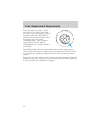
“Tread Lightly” is an educational
program designed to increase public
awareness of land-use regulations
and responsibilities in our nations
wilderness areas. Ford joins the U.S.
Forest Service and the Bureau of Land Management in encouraging you
to help preserve our national forest and other public and private lands by
“treading lightly.”
Water
Before driving through water,
determine the depth. Avoid water
higher than the bottom of the wheel
hubs. Proceed slowly to avoid
splashing, if the ignition system gets
wet, the vehicle may stall.
Once through water, always try the
brakes. Wet brakes do not stop the
vehicle as effectively as dry brakes. You can dry the brakes faster by
driving the vehicle slowly while applying light pressure on the brake
pedal.
Deep snow
4WD and AWD vehicles are unique in that they can be driven in deep
snow that would stop a conventional two-wheel drive vehicle. Shift to a
low gear and maintain steady pressure on the accelerator. This will help
prevent spinning the wheels while maintaining sufficient momentum to
keep from bogging down. Using tire chains will also help.
Never drive with chains on the front tires of 4WD or AWD vehicles
without also putting them on the rear tires. This could cause the rear to
slide and swing around during braking.
Driving on hills
Although natural obstacles may make it necessary to travel diagonally up
or down a hill or steep incline, you should always try to drive straight up
or straight down. Avoid driving crosswise or turning on steep
slopes or hills. A danger lies in losing traction, slipping sideways and
possibly rolling over. Whenever driving on a hill, determine beforehand
the route you will use. Do not drive over the crest of a hill without
seeing what conditions are on the other side. Do not drive in reverse
over a hill without the aid of an observer.
Driving Off-Road
10


















